

 |
Search the Site with

|
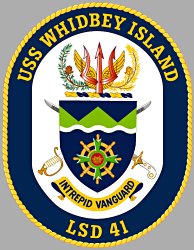 |  |
USS WHIDBEY ISLAND was the lead ship of the WHIDBEY ISLAND class of Dock Landing Ships and the first ship in the Navy named for Whidbey Island, Washington - a thirty five mile long island in Puget Sound north of Seattle. On July 22, 2022, WHIDBEY ISLAND held a decommissioning ceremony at her homeport Joint Expeditionary Base Little Creek-Fort Story, Va. On August 20, 2022, she was officially decommissioned and subsequently towed to Philadelphia, Penn., for lay-up.
| General Characteristics: | Awarded: February 9, 1981 |
| Keel laid: August 4, 1981 | |
| Launched: June 10, 1983 | |
| Commissioned: February 9, 1985 | |
| Decommissioned: August 20, 2022 | |
| Builder: Lockheed Shipbuilding, Seattle, Wash. | |
| Propulsion system: four Colt Industries 16 Cylinder Diesels | |
| Propellers: two | |
| Length: 610 feet (186 meters) | |
| Beam: 84 feet (25.6 meters) | |
| Draft: 21 feet (6.4 meters) | |
| Displacement: approx. 16,000 tons full load | |
| Speed: 22 knots | |
| Well deck capacity: four LCAC or 21 LCM-6 (on deck: one LCM-6, two LCPL and one LCVP) | |
| Aircraft: none, but two landing spots allow for operation of aircraft as large as the | |
| Crew: Ship: 20 Officers, 25 Chief Petty Officers, 302 Enlisted | |
| Marine Detachment: approx. 400 + approx. 100 surge | |
| Armament: two | |
| Cost: $339 million |
Crew List:
This section contains the names of sailors who served aboard USS WHIDBEY ISLAND. It is no official listing but contains the names of sailors who submitted their information.
USS WHIDBEY ISLAND Cruise Books:
About the Ship's Coat of Arms:
 The Shield:
The Shield:
The dark blue and white colors refer to the sea, with the angular green area, representing the vergreenterrain of WHIDBEY ISLAND, backed by blue sky. The color gold is symbolic of excellence, and the ship's wheel of gold reflects the sea-going pride and professionalism of the ship's crew. The green Maltese Cross refers to the humanitarian mission of USS WHIDBEY (AG 141), the first ship to carry the name WHIDBEY. The gold crown emblazoned on red at the center of the wheel recalls the expedition under the British Crown, which explored the Pacific Northwest in the 1790s. The island in these waters is named for Lieutenant Joseph Whidbey, who was a member of this English exploration. The crossed swords of the Navy and Marine Corps Officers attest to the Navy Marine Corps teamwork and leadership that are the foundation and key elements for accomplishment of WHIDBEY ISLANDís amphibious warfare mission.
The Crest:
The trident is the traditional symbol of sea power; however, the winged trident of LSD 41 further represents the revolutionary dimension of amphibious warfare this ship introduces. WHIDBEY ISLAND provides a quantum improvement in the projection of power ashore, with an increased capacity for vertical assault, combined with the new generation of Landing Craft Air Cushion (LCAC). Again, the gold and red colors of the winged trident portray the excellence and courage of those who will man the ship. The wreath of Western Hemlock, the State Tree of Washington, represents the spirit of the ship's namesake, which will accompany the ship to the distant quarters of the globe.
History of USS WHIDBEY ISLAND:
On February 9, 1981, the U.S. Navy awarded Lockheed Shipbuilding Company of Seattle, Washington a contract to construct LSD 41, first of a new class of Dock Landing Ship to replace the aging THOMASTON Class LSDs. At the August 4, 1981 keel laying ceremony, the Honorable John F. Lehman, Secretary of the Navy, affixed his signature to the LSD 41 keel: the first keel of an amphibious ship to be laid in more than five years. During the ceremony, Secretary Lehman announced that the LSD 41 would be named WHIDBEY ISLAND and the ship's sponsor was to be Mrs. Sally Gorton, wife of Senator Slade Gorton from the state of Washington. Although this ship is the first to carry the name WHIDBEY ISLAND, there was at one time a ship on the Navy's rolls called USS WHIDBEY (AG 141). This was a small transport purchased from the U.S. Army and saw service in the U.S. Trust Territories in the late 1940s.
USS WHIDBEY ISLAND is the first ship in a class designed specifically to interface with the Navy's newest amphibious assault landing craft, the Landing Craft Air Cushion, or LCAC. WHIDBEY ISLAND further assisted in the operational and developmental testing of the LCAC from July to September 1985 and again in May and July 1986. In August 1986, WHIDBEY ISLAND embarked on her first major operation, participating in the NATO exercise Northern Wedding/Bold Guard '86. WHIDBEY ISLANDís first major deployment was to the Mediterranean in January 1987 where the ship was involved in seven amphibious landing exercises, as well as carrying out assigned duties as Presidential support ship for the World Economic Summit held in Venice, Italy in May 1987.
WHIDBEY ISLAND Deployed to the Mediterranean for the second time in December 1988 with MARG 1-89, participating in three major landing exercises with the Spanish, French and Italian Navies before returning to homeport in July 1989. WHIDBEY ISLAND was the first East Coast amphibious ship to deploy to the European Theater with LCACs. In September and October 1989, WHIDBEY ISLAND participated in Hurricane Hugo Disaster Relief Operations in the Caribbean Sea. In August 1990, WHIDBEY ISLAND deployed again to the Mediterranean as part of MARG 3-90. During the trans-Atlantic crossing, the ship received orders to sail to MAMBA Station off the coast of Monrovia, Liberia to serve as the flagship for the evacuation operations in Operation Sharp Edge, spending 105 consecutive days at sea. By the time WHIDBEY ISLAND reached its first port; Las Palmas, Canary Islands, the ship had been out to sea 126 straight days. After further steaming around the Western Mediterranean in support of Operation Desert Storm, WHIDBEY ISLAND returned to homport in March 1991 from the extended seven-month deployment.
WHIDBEY ISLAND deployed again, on December 5, 1992, with MARG 1-92. During this deployment, WHIDBEY ISLAND was chosen to represent the amphibious ready group for operations in the Black Sea with a series of port calls there. With members of Sixth Fleet, the USS INCHON Band and representative from the other MARG ships, WHIDBEY ISLAND made history by making port calls to Samsun, Turkey; Constanta, Romania; and Burgas, Bulgaria. WHIDBEY ISLAND became the first U.S. amphibious ship and largest U.S. warship to operate in the Black Sea; the first U.S. Navy ship to visit Samsun in 70 years and the first U.S. Navy ship to ever visit Burgas. WHIDBEY ISLAND returned to homeport on June 5, 1992.
In January 1993, WHIDBEY ISLAND deployed in support of Operation Sea Signal/Able Manner, enforcing alien migration policies off the coast of Haiti. Later that year, she deployed again to the littorals of South America and West Africa during Unitas 34-93/West African Training Cruise (WATC) 93. The first WHIDBEY ISLAND class ship to deploy to this region, WHIDBEY ISLAND made history by leading the southernmost amphibious exercise ever at Tierra Del Fuego. The ship returned from deployment on December 17, 1993.
In 1994 WHIDBEY ISLAND provided emergent lift services for evacuation of Combined Task Force 160 migrant camps from Grand Turk Island; rescued and transported over 8,100 Cuban migrants from the Straits of Florida during Operation Able Vigil and participated in the restoration of the legitimate government to Haiti during Operation Uphold Democracy. For this, the crew was awarded the Armed forces service Medal and NATO Medal. The ship returned to NAB Little Creek on February 29, 1996. Following a Dry-docking Phased Maintenance Availability, WHIDBEY ISLAND underwent a condensed training cycle to prepare for the upcoming Unitas 38-97/ WATC 97 deployment that would begin on July 1, 1997. Before returning to homeport on December 13, 1997, WHIDBEY ISLAND successfully conducted an unprecedented number of multi-national amphibious assaults.
In February and March of 1998, WHIDBEY ISLAND conducted LCAC skirt testing in Panama City, Florida. During her most recent inter-deployment training cycle, WHIDBEY ISLAND received Direct-to-Sailors Satellite Television System and completed the IT-21 upgrade providing internet access to Sailors and Marines aboard. Currently, WHIDBEY ISLAND is deployed to the Mediterranean with the COMPHIBRON SIX and MEU(SOC) serving as MARG 3-99. She participated in Exercise Bright Star and on October 18, with the USNS CONCORD (T-AFS 5), became the first LSD 41 class ship to conduct simultaneous connected underway replenishment for stores and fuel.
In June 2006, WHIDBEY ISLAND deployed in support of Operation Enduring Freedom. While in-port Aqaba, Jordan in July of 2006, the ship was recalled through the Suez Canal to support contingency operations due to the crisis in Lebanon. WHIDBEY ISLAND subsequently participated in the largest non-combatant evacuation conducted by the US Navy since Vietnam. During July and August, the ship evacuated 817 American citizens via LCAC with personnel transport module.
On February 16, 2007, WHIDBEY ISLAND was awarded the 2006 Battle "E" award.
On October 1, 2007, WHIDBEY ISLAND deployed from Little Creek Naval Amphibious Base. After being deployed to the Horn of Africa, she assisted the M/V AL MARJAN and its crew when they were released by Somali pirates.
On June 24, 2016, WHIDBEY ISLAND deployed from Joint Expeditionary Base Little Creek-Fort Story, for what would be her final deployment. She conducted eight Theater Security Port Visits; country visits vital to reassuring host nations of the commitment of the United States to their partnership. On July 21, 2016, WHIDBEY ISLAND transited the Bosphorus Strait during a time of tension following the failed 2016 Turkish coup d'ťtat attempt.
USS WHIDBEY ISLAND Image Gallery:
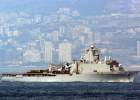 | 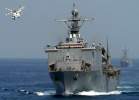 |
The photos below were taken by Brian Barton when USS WHIDBEY ISLAND was at Naval Base Norfolk on July 23, 2002.
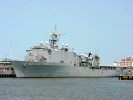 | 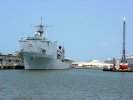 |
The photos below were taken by me and show the USS WHIDBEY ISLAND at her homeport of Little Creek, Va., on November 11, 2008.
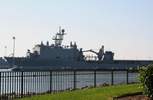 | 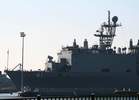 |
The photos below were taken by Steven Collingwood and show the USS WHIDBEY ISLAND after departure from Little Creek, Va., on July 27, 2015.
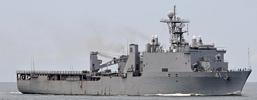 | 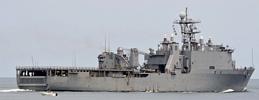 |
The photo below was taken by Steven Collingwood and shows the USS WHIDBEY ISLAND returning to Little Creek, Va., on August 5, 2015, after completing a 9-day underway for routine training.
 |
The photos below were taken by Michael Jenning and show the USS WHIDBEY ISLAND at the Marine Hydraulics Industries (MHI) Ship Repair & Services shipyard in Norfolk, Va., for a Phased Maintenance Availability (PMA) on October 4, 2017.
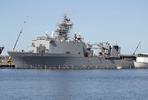 |  | 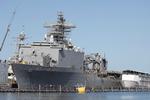 |
The photos below were taken by Michael Jenning and show the USS WHIDBEY ISLAND at the Marine Hydraulics Industries (MHI) Ship Repair & Services shipyard in Norfolk, Va., for a Phased Maintenance Availability (PMA) on September 21, 2018.
 | 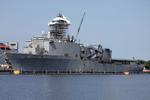 | 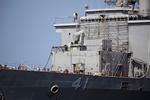 | 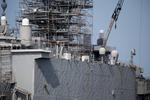 |
 Back to Dock Landing Ship site.
Back to Dock Landing Ship site.  Back to ships list.
Back to ships list.  Back to selection page.
Back to selection page.  Back to 1st page.
Back to 1st page.